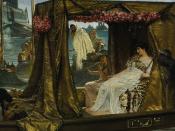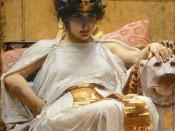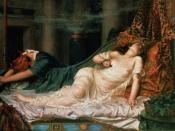For nearly 2,000 years Cleopatra VII has been an infatuation of societies and a fascinating conundrum for historians. She has drawn the attention of artists working in every genre and has been portrayed in every medium. The significance of Cleopatra's legacy is the score of representations of her, many of which carry a great deal of political, social, and racial weight, and all of which have been debated. There is still no consensus on her appearance, actions, or intentions. Each image of Cleopatra provides clues to the nature of the culture in which it was produced. In this paper I will use the Renaissance to exemplify the ability of Cleopatra's conception to be transformed by a society in order to manifest its viewpoints.
During the Renaissance unprecedented shifts were occurring in political, social, and religious ideologies. Reconstructions of Cleopatra from this era embody these changes and reflect the conflicting philosophies of society.
The Renaissance followed the Middle Ages, a time in which all aspects of life were permeated by Catholicism. Throughout this period, the Roman Catholic Church reigned supreme and governed all aspects of society's daily life through its Christian dogma. All art of the Middle Ages reflected the devout ideologies of the time and was solely related to Catholicism . However, several factors lead to the decline in the power of the Roman Catholic Church. The collapse of feudalism, the threat of invasion by the Ottoman Empire, the beginning of the Great Schism, and the bubonic plague all contributed to the deterioration in the faith of Catholicism . This political, social, and religious turmoil prompted society to embrace a new humanist rationale, and thus the Renaissance began.
Humanism was the spirit and approach to life that embodied the Renaissance. Up until the latter Middle Ages, almost...


